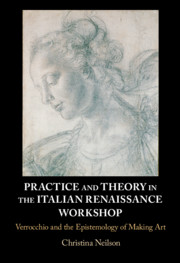 Practice and Theory in the Italian Renaissance Workshop
Practice and Theory in the Italian Renaissance Workshop Book contents
- Practice and Theory in the Italian Renaissance Workshop
- Practice and Theory in the Italian Renaissance Workshop
- Copyright page
- Dedication
- Contents
- Acknowledgments
- Introduction Verrocchio Experimentalist
- 1 Verrocchio's Ingenuity
- 2 Verrocchio's Medici Tomb: Art as Treatise
- 3 Bridging Dimensions: Verrocchio's Christ and Saint Thomas as Absent Presence
- 4 The Sculptured Imagination
- 5 Material Meditations in Verrocchio's Bargello Crucifix
- Conclusion
- A Note on Archival Sources
- Bibliography
- Notes
- Index
5 - Material Meditations in Verrocchio's Bargello Crucifix
Published online by Cambridge University Press: 06 July 2019
- Practice and Theory in the Italian Renaissance Workshop
- Practice and Theory in the Italian Renaissance Workshop
- Copyright page
- Dedication
- Contents
- Acknowledgments
- Introduction Verrocchio Experimentalist
- 1 Verrocchio's Ingenuity
- 2 Verrocchio's Medici Tomb: Art as Treatise
- 3 Bridging Dimensions: Verrocchio's Christ and Saint Thomas as Absent Presence
- 4 The Sculptured Imagination
- 5 Material Meditations in Verrocchio's Bargello Crucifix
- Conclusion
- A Note on Archival Sources
- Bibliography
- Notes
- Index
Summary
Verrocchio transferred tools and techniques from different media to create his ostensibly wooden Crucifix. Made from limewood, the body was built up with layers of stucco rather than carving in wood. The head and shoulders, made from cork, were attached to the body using nails like an armorer attaching pauldrons to armor. The body of the figure was carved out to a precise depth of 12 mm like a sculpture in bronze. The loincloth was made from linen dipped in gesso, like the three-dimensional models Verrocchio used in preparation for his painted drapery studies on linen. And the entire figure was painted in tempera over charcoal like a panel painting. The layered manufacture is compared to Renaissance vernacular poetry, especially the poems of Burchiello, and devotional literature, especially Ugo Panziera. Verrocchio’s unusual techniques are combined to make material Christ’s in-between nature at the Crucifixion (between life and death). Although Verrocchio’s techniques are not apparent to the eye, they were meaningful; they were intended to suggest materially the nature of Christ’s body at the moment of his death: as a body that was dead but behaving as if it was alive.
- Type
- Chapter
- Information
- Practice and Theory in the Italian Renaissance WorkshopVerrocchio and the Epistemology of Making Art, pp. 168 - 195Publisher: Cambridge University PressPrint publication year: 2019
